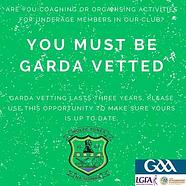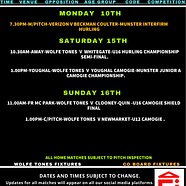Over the years the concept of “practicing to win” has led to the creation of several developmental theories/models, e.g. 10,000 hours rule, deliberate practice, early specialization, etc; as well as other informal phrases and associated quotes from sporting icons.
Muhammad Ali was once quoted to say, “You have to put in the work away from the lights in order to shine and win under those lights; the better you get, the better it gets.” A basic interpretation of the above quote would suggest that in order to achieve our desired goals on game-day, we need to have adequately prepared ourselves beforehand; otherwise we increase the likelihood of failure during our playing season.
Coaches of winter sports, such as ice hockey or speed skating, may allude to the need of beginners to “smack the ice;” or I’m sure we’re all familiar with “practice makes perfect,” directed our way as children when learning to ride a bicycle or play a new musical tune. These phrases are examples of where colloquial (basic) language is used to motivate athletes to continue practicing - however in recent times I’ve begun to question the merit of using such language regarding sporting practice. Does practice always lead to perfection? If so, why and how do skill deficiencies or developmental “gaps” appear? Perhaps practice is far more complex than just repetition after repetition – thus how can we help our young players become technically proficient in Gaelic games?
THE COMFORT ZONE – THE NIGHTMARE OF LEARNING
In today’s society many of us live in fear of failure; as it is often wrongly perceived as a sign of weakness or inferiority. Sporting environments are no different – as the majority of us would much rather to remain in our “comfort zone,” free from the ridicule of others, or the sense of rejection and self-pity. Unfortunately many coaches and players fall into this trap, and never have the opportunity to reach their full potential, i.e. coaches will coach, and players will practice, the elements of the game which they are most comfortable. Consequently “gaps” are created, limiting the knowledge and ability of coaches, which of course has a detrimental effect on the technical structure of players.
“When you fall short of the goal, the let-down can be so severe that you’re blinded to substantial information indicating that success may be closer than you would imagine,”– Bill Walsh, former NFL Head Coach, describing “the process” associated with player development. Players that aren’t exposed to a learning environment (beyond the comfort zone) will never acquire the necessary feedback, by means of trial and error. This information is central to the learning process of any given technical skill, and without it “gaps” begin to foster within an athlete.
THE DEVELOPMENT OF SKILL DEFICIENCIES (GAPS)
Coaching philosophy is a factor that can influence the technical proficiency of children i.e. whether or not the skill deficiency is allowed to develop. If a coach is ego-orientated and solely focused on winning; they are not interested in long-term player development. Therefore it is likely that his/her players will lack specific technical skills in later years. Unfortunately these players have been set-up to fail, because they will likely encounter an opponent who is capable of exposing their deficient (lacking) skills.
Player ego can also determine his/her developmental potential. The majority of children will adopt an ego similar to that of their coach (highlighting the coach’s influential role). If a coach adopts a “win-at-all-costs” mentality, he/she will identify the team’s best player and instruct that player never to pass i.e. “take your own score.” The actions of this coaching style may lead to a young player becoming reliant on their favourite foot (football) or side (hurling/camogie). Eventually over-reliance leads to incompetence in game situations; especially when a player’s preferred foot to kick with, or side to strike off, is unavailable due to an opposing player. However if a young hurler or footballer is accumulating large scores on a weekly basis it may prove very difficult for any coach, regardless of coaching philosophy, to encourage them to practice their less-favoured foot/side, or to pass the ball to teammates. Unfortunately we do not live in an ideal world, as human nature (instinct) dictates the decisions we make – children are no different.
THE BENEFITS OF TECHNICAL PROFICIENCY
In total contrast, if a coach is effort-orientated and focused on skill development; they are committed to improving the technical proficiency of young GAA players. Children exposed to this coaching style tend to mature into high skilled players, as they get the opportunity to practice all aspects of gameplay – the scoreboard is not a priority! These coaches seek an honest effort which allows children to make their own decisions on the field of play. This enables all players to feel respected and equal, further promoting technical proficiency within the group.
Coaches may also challenge players to self-create a scenario where being technically proficient could improve their performance, e.g. “Jimmy/Suzie if you were able to kick with both feet/strike off both sides, what advantage would that give you on the field?”– he/she might reply, “I would be able to create that bit more space for myself to take the score, or to pass the ball inside to the forwards, or to clear the ball further from our defence.”
IMPLICATIONS FOR COACHES
The most common error made by GAA coaches, leading to the development of “gaps”, is failure to review their coaching methods - regardless of the session frequency, intensity, type or time (FITT). Are our players really improving if they practice the exact sametechnical skills week in, week out? The answer of course is no, because we will continue to make the exact same mistakes week in, week out, if we don’t reflect on our practice/training sessions. A coach could form a discussion with his/her player(s) around the following three guidelines; 1) effective elements of the session, 2) ineffective elements of the session, and 3) elements to be altered. Many coaches identify the process of self-reflection (review) as a key component to unearthing flaws within practice, helping to create more effective training strategies, and thus more technically skilled players.
GAA players can also be exposed to skill tests, which are a beneficial method of monitoring technical proficiency over time. Coaches can use these tests to demonstrate improvement to a young player, which could act as further motivation for the child. There are a multitude of tests available from online GAA resources, which can be easily adapted to the skill and age requirements of the player(s).
In the 2016 All-Ireland Senior Football Finals, Cormac Costello (Dublin) was the only player to score off both feet in either of the two matches (drawn game & replay) - no Mayo player was able to do likewise. Cormac came off the bench with 15 minutes to go and proved to be the match winner, kicking three points from open-play. Despite playing at the very highest standard, the Mayo players were exposed by their Dublin counterparts who forced them to kick off their less-favoured foot, or else recycle the ball (go backwards). If #Mayo4Sam is ever to become a reality, the players will have to become more technically proficient … so avoid the curse, and “mind the gap.”







